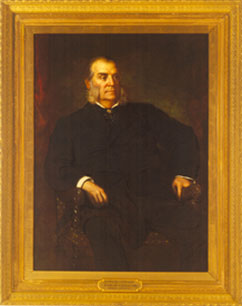Appointed Secretary of the Treasury in 1881 by President Chester A. Arthur, Charles J. Folger (1818 - 1884) presided over the greatest surplus the Government had ever had. With some humor he observed that times had changed since the first Treasury Secretary in 1789 was charged with devising plans for the collection of revenue; "What now perplexes the secretary is not wherefrom he may get revenue enough for the pressing needs of the government, but whereby he shall turn back into the flow of business the more than enough for those needs, that has been drawn from the people."

Sec. Charles J. Folger
Eastman Johnson
Oil on canvas
1883 circa
62 1/8 x 49 x 3 7/8"
P.1884.1
He considered several options, including using the surplus to pay off the federal debt or depositing it with commercial banks, both of which were of questionable legality. Finally, Folger advocated reducing the Customs duties. However, a reduction in Internal Revenue rates together with a decrease in Customs receipts in 1884 cut down the Government's income and put off until 1890 the need for decisive action to prevent a surplus. In 1883 Folger oversaw the reclassification of the Treasury Department according to Civil Service rules. He died in office the next year.
About the Artist
Eastman Johnson (1824 - 1906), the well-known genre and portrait painter, was born in 1824 in Lowell, Maine, where his father served as secretary of state. He began his portrait career early, depicting members of the Maine legislature and their families. In 1845, Johnson's father took a job as Chief Clerk in the Bureau of Construction of the Navy Department and the family moved to Washington, D.C. Continuing his portraiture, the younger Johnson established a studio in the basement of the U.S. Capitol where he painted Alexander Hamilton's widow and Daniel Webster, among others. Johnson painted many official portraits for the White House, the Capitol, and various governmental Departments; his oeuvre reads like a Who's Who of nineteenth-century America. His portrait of Charles J. Folger was probably painted during Folger's last year in office.
Office of the Curator
All rights reserved. 2001